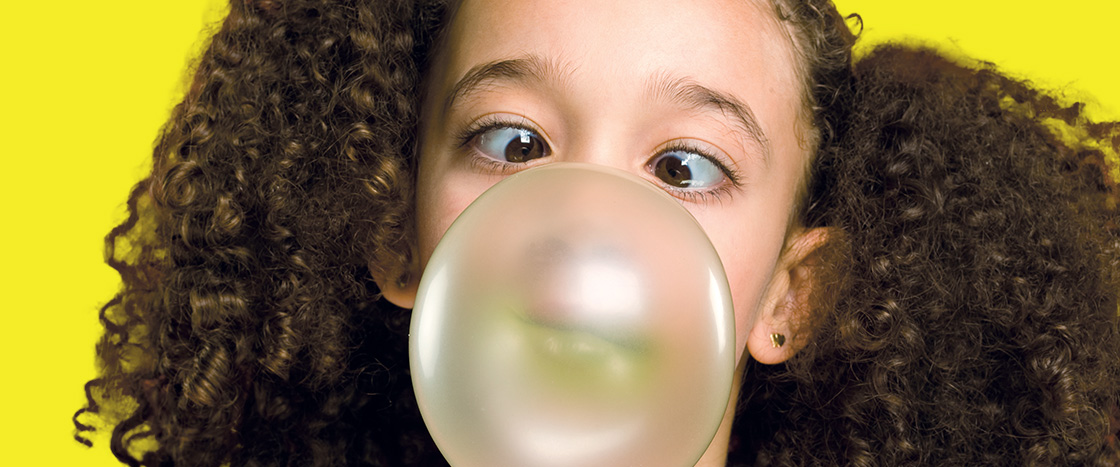WORD HUNT!
In the article, find:
- 3 verbs that mean chewed
- 2 verbs that mean to stick
- 1 idiom that means to think about
WORD HUNT!
In the article, find:
- 3 verbs that mean chewed
- 2 verbs that mean to stick
- 1 idiom that means to think about

WORD HUNT!
In the article, find:
WORD HUNT!
In the article, find:
AdShooter/Getty Images
Do you chew gum when you want a sweet treat? To ban bad breath? Or to show off your bubble-blowing abilities?
Whatever your reason for chewing, blowing, or popping, you’re taking part in something humans have done for more than 10,000 years. Back in the day, gum was made from resin—a bitter, sticky sap that oozed out of trees.
Ancient Greeks masticated resin to keep their teeth healthy. (It worked!) Some Native Americans chewed it to freshen their breath. But it wasn’t until the 1800s that gum turned into the popular goody we know today.
Do you chew gum when you want a sweet treat? To get rid of bad breath? Or to show off your bubble-blowing skills?
Whatever your reason for chewing gum, you’re doing something that humans have done for more than 10,000 years. In the past, gum was made from resin. Resin is a bitter, sticky juice that oozes out of trees.
Ancient Greeks masticated resin to keep their teeth healthy. (It worked!) Some Native Americans chewed it to freshen their breath. But gum didn’t turn into the popular treat that we know today until the 1800s.
A Tastier Idea
AdShooter/Getty Images
In the late 1850s, inventor Thomas Adams was trying to create a new type of rubber for things like bike tires and toys. His main ingredient was chicle (CHIH-kuhl), a resin from trees found in Mexico. Adams’s experiments failed. But then he remembered that people in Mexico munched on chicle. Would Americans do the same?
He started selling his chicle gum around New York City. And people—especially kids—loved it! His gum was easier to chew than any other sold at the time.
From there, Adams added flavors like sour orange and licorice—and the gum business exploded. By the 1920s, the average American chomped on 105 sticks of gum a year.
In the late 1850s, inventor Thomas Adams was trying to create a new type of rubber for things like bike tires and toys. His main ingredient was chicle (CHIH-kuhl). Chicle is a resin from trees found in Mexico. His experiments failed. But then Adams remembered something: People in Mexico munched on chicle. Would Americans do the same?
He started selling his chicle gum around New York City. And people—especially kids—loved it! His gum was easier to chew than any other sold at the time.
Adams started adding flavors like sour orange and licorice. And the gum business exploded. By the 1920s, the average American chomped on 105 sticks of gum a year.
A Lucky Discovery
Keith Homan/Alamy Stock Photo
But there was a big problem. Gum was so sticky that if it escaped from your mouth, it would cling to your face. Then, in 1928, a man named Walter Diemer made a lucky discovery.
Diemer worked for a candy company. He loved experimenting with gum recipes. One day, he created a new gum that easily stretched into bubbles—and didn’t adhere to skin. He added pink coloring because it was the only kind he had. Dubble Bubble was born! Soon kids everywhere were blowing his gooey invention into big pink bubbles.
Today, bubble gum is still often pink—but it’s not made from tree resin anymore. (Most gum is made from edible plastic.) And there are hundreds of flavors, from mint to pickle.
So what will “pop” up next in the sweet, sticky history of gum? That’s something for you to chew on.
But there was a problem. Gum was very sticky. If it got out of your mouth, it would cling to your face. Then, in 1928, a man named Walter Diemer made a lucky discovery.
Diemer worked for a candy company. He loved making new gum recipes. One day, he created a new gum that easily stretched into bubbles. And it didn’t adhere to skin. He added pink coloring because it was the only kind he had. Dubble Bubble was born! Soon kids everywhere were blowing his new gum into big pink bubbles.
Today, bubble gum is still often pink. But it’s not made from tree resin. (Most gum is made from a type of plastic that can be eaten.) And there are hundreds of flavors, from mint to pickle.
So what will “pop” up next in the history of gum? That’s something for you to chew on.
FACT FINDER!
WHAT is resin?
WHO invented Dubble Bubble?
WHAT is gum made from today?
FACT FINDER!
WHAT is resin?
WHO invented Dubble Bubble?
WHAT is gum made from today?
This article was originally published in the May/June 2023 issue.
This article was originally published in the May/June 2023 issue.